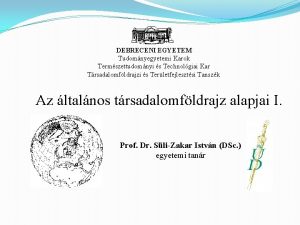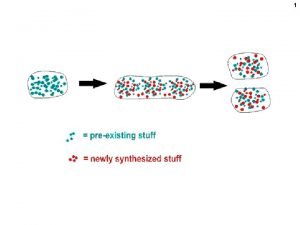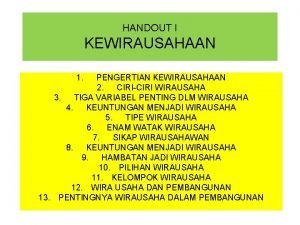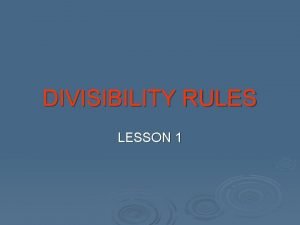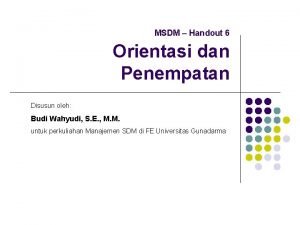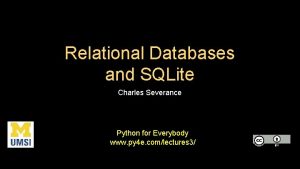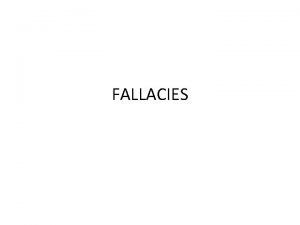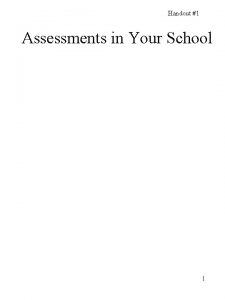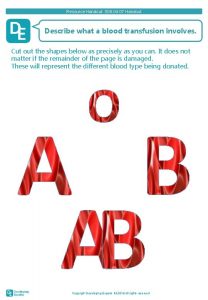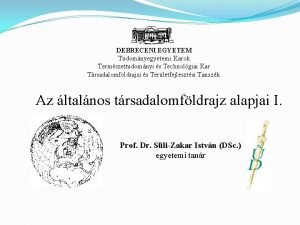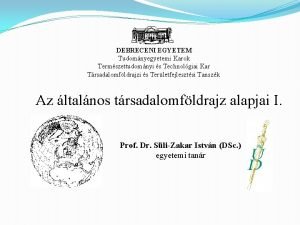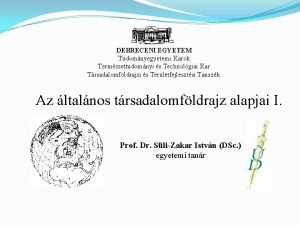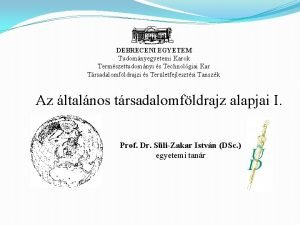Handout 11 Karok cf Handout 7 Karok California






![Karok: Distribution of alternating sounds • s ~ S (Handout #7) – [S] occurs Karok: Distribution of alternating sounds • s ~ S (Handout #7) – [S] occurs](https://slidetodoc.com/presentation_image_h/8c196df40fb221851bb614b1a2a3efb8/image-7.jpg)





![Rules • Palatalization (Handout #7) – [+cor, -son, +cont] --> [-ant] / • Vowel Rules • Palatalization (Handout #7) – [+cor, -son, +cont] --> [-ant] / • Vowel](https://slidetodoc.com/presentation_image_h/8c196df40fb221851bb614b1a2a3efb8/image-13.jpg)

![Rule ordering • In [nik. Sup], the underlying representation is /ni uksup/. • Palatalization Rule ordering • In [nik. Sup], the underlying representation is /ni uksup/. • Palatalization](https://slidetodoc.com/presentation_image_h/8c196df40fb221851bb614b1a2a3efb8/image-15.jpg)




- Slides: 19

Handout #11 Karok (cf. Handout #7)

Karok (California) (Kenstowicz and Kisseberth 1979: 73) Imperative 1 st sing. 3 rd sing. Gloss pasip nipasip /upasip shoot si˘tva ni. Si˘tva /usi˘tva steal kifnuk nikifnuk /ukifnuk stoop suprih ni. Suprih /usuprih measure /ifik ni/ifik /u/ifik pick up /aktuv ni/aktuv /u/aktuv pluck at

Karok (California) Imperative 1 st sing. 3 rd sing. Gloss /axjar nixjar /uxjar fill /i. Skak ni. Skak /uskak jump /ik. Sah nik. Sah /uksah laugh /i. Sriv ni. Sriv /usriv /uksup nik. Sup /uksup shoot at target point

Karok: Nonalternating morphemes • • • ni/upasip kifnuk /aktuv /ifik “ 1 st singular”. “ 2 nd singular” “shoot” “stoop” “pluck at” “pick up”

Karok: Alternating morphemes • si˘tva ~ Si˘tva • • • suprih ~ Suprih /axjar ~ xjar /i. Skak ~ skak /ik. Sah ~ ksah /i. Sriv ~ sriv /uksup ~ k. Sup ~ ksup “steal” “measure” “fill” “jump” “laugh” “shoot at target” “point”

Karok: Alternating sounds • • • s~S i~ø u~ø a~ø /~ø
![Karok Distribution of alternating sounds s S Handout 7 S occurs Karok: Distribution of alternating sounds • s ~ S (Handout #7) – [S] occurs](https://slidetodoc.com/presentation_image_h/8c196df40fb221851bb614b1a2a3efb8/image-7.jpg)
Karok: Distribution of alternating sounds • s ~ S (Handout #7) – [S] occurs only after V C 0. [-back] – [s] occurs only elsewhere.

Karok: Distribution of alternating sounds • /~ø – The alternants with the glottal stop, e. g. /axjar, occur at the beginning of the word. – The alternants without glottal stop, e. g. xjar, occur after a vowel. – Forms like ni/ifik and /u/aktuv indicate that glottal stop can occur after i or u. – The restriction must be on the alternant without the glottal stop - it can’t occur word-initially. – Statement of distribution: *#V

Karok: Distribution of alternating sounds • i, a, u ~ ø – The alternants with the vowel, e. g. /axjar, occur at the beginning of the word. – The alternants without the vowel, e. g. xjar, occur after a vowel. – It differs from item to item what the alternating vowel is. – Statement of distribution: * V V

Underlying representations of alternating morphemes • /si˘tva, suprih, axjar, iskak, iksah, isriv, uksup/ • Comments – s and S are in complementary distribution, with s in the default elsewhere distribution. – Therefore /s/ is the phoneme, and all underlying representations have /s/ in place of [S]. – Examples: /si˘tva, suprih, iskak, iksah, isriv, uksup/

Underlying representations of alternating morphemes • V~ø – The restriction is on the presence of the vowel in a position next to a vowel. – The underlying representations of the alternating morphemes therefore have the alternating vowel. – Examples: /axjar, iskak, iksah, i. Sriv, uksup/

Underlying representations of alternating morphemes • /~ø – The restriction is on the form without the glottal stop, with a vowel at the beginning of a word. – The underlying representations of the alternating morphemes therefore have the restricted form - without glottal stop. – Examples: /axjar, iskak, iksah, i. Sriv, uksup/
![Rules Palatalization Handout 7 cor son cont ant Vowel Rules • Palatalization (Handout #7) – [+cor, -son, +cont] --> [-ant] / • Vowel](https://slidetodoc.com/presentation_image_h/8c196df40fb221851bb614b1a2a3efb8/image-13.jpg)
Rules • Palatalization (Handout #7) – [+cor, -son, +cont] --> [-ant] / • Vowel Deletion – V --> ø / V ___ • Glottal Stop Insertion – ø --> C / # ____ [+constricted] V C 0 ___ [-back]

Rule ordering • Vowel Deletion and Palatalization interact, because the former gets rid of vowels, and the latter is conditioned by vowels. • In a case like [/usriv], the underlying representation is //u - isriv/. • Palatalization would apply to the underlying representation, but not to the output of Vowel Deletion: //u - sriv/. • In this case, Vowel Deletion bleeds Palatalization, i. e. it eliminates some opportunities for the latter to apply.
![Rule ordering In nik Sup the underlying representation is ni uksup Palatalization Rule ordering • In [nik. Sup], the underlying representation is /ni uksup/. • Palatalization](https://slidetodoc.com/presentation_image_h/8c196df40fb221851bb614b1a2a3efb8/image-15.jpg)
Rule ordering • In [nik. Sup], the underlying representation is /ni uksup/. • Palatalization does not apply to this representation, but it does apply to the output of Vowel Deletion: /ni - ksup/. • In this case, Vowel Deletion creates an opportunity for Palatalization to apply, i. e. Vowel Deletion feeds Palatalization. • Therefore Vowel Deletion must be applied before Palatalization.

Derivations: Correct order Underlying representation //u - isriv/ /ni - uksup/ Vowel Deletion //u - sriv/ /ni - ksup/ Palatalization _____ /ni - k. Sup/ Surface representation [/usriv/ [nik. Sup]

Derivations: Incorrect order Underlying representation //u - isriv/ /ni - uksup/ Palatalization //u - i. Sriv/ ______ Vowel Deletion //u - Sriv/ /ni - ksup/ Surface representation *[/u. Sriv/ *[niksup]

Rule ordering • Vowel Deletion must be applied before Palatalization. • Glottal Stop Insertion does not interact with the other two rules, so any ordering of that rule with the other two works.

Reference • Kenstowicz, Michael and Charles Kisseberth (1979). Generative Phonology: Description and Theory. Academic Press, San Diego.
 Karantánok
Karantánok Debreceni egyetem karok
Debreceni egyetem karok Debreceni egyetem karok
Debreceni egyetem karok Dyphagia
Dyphagia Karakteristik handout
Karakteristik handout Handout 5-2 graphic organizer the brain answers
Handout 5-2 graphic organizer the brain answers Chapter 7 cengage
Chapter 7 cengage Journey 2050 student handout 2 word search
Journey 2050 student handout 2 word search Handout
Handout Ciri-ciri handout
Ciri-ciri handout Johari window handout
Johari window handout Which nutrient practice was best journey 2050
Which nutrient practice was best journey 2050 Wise mind handout
Wise mind handout Cheo constipation handout
Cheo constipation handout Divisibility rules handout
Divisibility rules handout Assertive response examples
Assertive response examples Pengertian orientasi
Pengertian orientasi Py4e database handout
Py4e database handout Lecture handout
Lecture handout Non sequitur fallacy
Non sequitur fallacy

